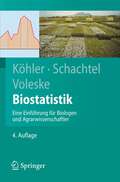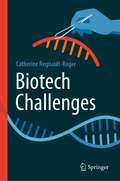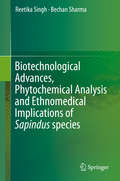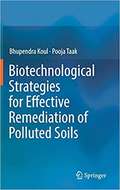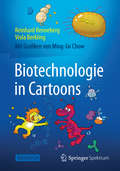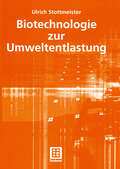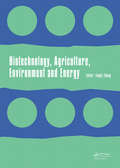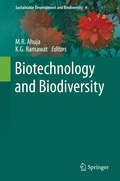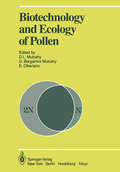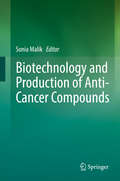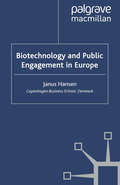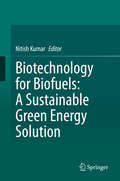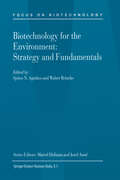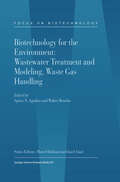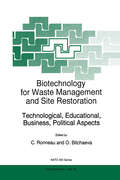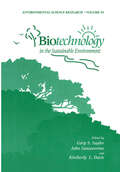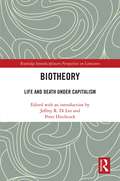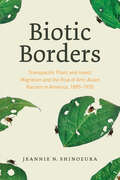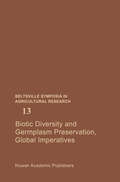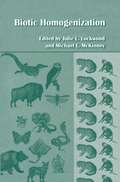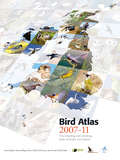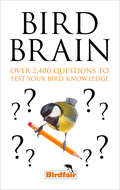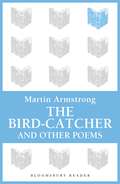- Table View
- List View
Biostatistik (Springer-Lehrbuch)
by Wolfgang Köhler Gabriel Schachtel Peter VoleskeBiostatistik: die Vermessung des Lebendigen. Diese bewährte und leicht verständliche Einführung in die Biometrie eignet sich für all jene, die rasch statistische Verfahren zur Auswertung experimenteller Ergebnisse erlernen möchten. Die Autoren stellen Grundlagen und Anwendung gleichermaßen dar. Dabei berücksichtigen sie insbesondere biologische und agrarwissenschaftliche Beispiele. Sie vermitteln Anwendern ein Verständnis für die hinter dem Verfahren stehende Grundidee und vermeiden dabei weitgehend Formeln und mathematische Symbolik. Übersichtliche Anleitungen regen dazu an, die Verfahren anhand der Beispieldaten wirklich nachzurechnen.
Biotech Challenges
by Catherine Regnault-RogerThe evolution of genome’s modification by genetic engineering was characterized by a major technological breakthrough with the discovery of CRISPR in 2012. A distinction is now made between first-generation biotechnologies developed in the 20th century and current second-generation biotechnologies, NGT or New Genomic Techniques, including genome editing. How do we consider these genomic modifications compared to those that occur spontaneously in nature? What are the applications of these techniques in the fields of plants, animals, and human health? What prospects in terms of development and independence for countries and at least what regulations are in force on the different continents?The book questions what GMOs are, genome editing products and the place of genomic transformations today and tomorrow in our societies. It tries to give some geostrategic and regulatory benchmarks on biotech products in order to better understand the current issues.
Biotechnological Advances, Phytochemical Analysis and Ethnomedical Implications of Sapindus species
by Reetika Singh Bechan SharmaPlants have always occupied a prominent position in the life of every living being. Plants are the primary source of food, shelter and medicines. The global inclination toward herbal medicine has advanced the expansion of plant-based pharmaceutical industries to a vast extent. The production of traditional medicine at global market has been estimated to touch US $5 trillion by 2050. Some of the useful plant-based drugs include vinblastine, vincristine, taxol, podophyllotoxin, camptothecin, digoxigenin, morphine, codeine, aspirin, atropine, capscicine, allicin, curcumin, artemesinin and ephedrine. Genus Sapindus is an important economical and medicinal trees, distributed over the world. Soap nuts contain higher amount of saponin, a natural detergent which can be used to clean clothes and hairs. Sapindus species possesses various pharmacological properties including antimicrobial, antioxidant, anti-inflammatory, anticancer, hepatoprotective, anti-trichomonas activity. Extracts of this plant are rich in various phytochemicals and polyphenolic compounds. All the pharmacological properties are due to presence of saponins. Biotechnological techniques can improve the saponin content; thus this chemical content can be produced at large scale and can be used as phytomedicine. We hope that this book would be of great use to under graduates, postgraduates, scientists, researchers and faculty members who are studying, teaching or working in the field of Biotechnology, Phytochemistry and Ethnopharmacology. The techniques explained in this book could be of immense use for the researchers working in this area. We shall deeply appreciate receiving any critical comments and suggestions from the readers from the different parts of globe which would help us improve the first edition of this publication.
Biotechnological Strategies for Effective Remediation of Polluted Soils
by Bhupendra Koul Pooja TaakThis book presents a comprehensive collection of various in situ and ex-situ soil remediation regimes that employ natural or genetically modified microbes, plants, and animals for the biodegradation of toxic compounds or hazardous waste into simpler non-toxic products. These techniques are demonstrated to be functionally effective in connection with physical, chemical, and biological strategies. Soil and water contamination through heavy metals, hydrocarbons and radioactive wastes is of global concern, as these factors have cumulative effects on the environment and human health through food-chain contamination. The book discusses the utilization of algae, plants, plant-associated bacteria, fungi (endophytic or rhizospheric) and certain lower animals for the sustainable bioremediation of organic and inorganic pollutants. In addition, it explores a number of more recent techniques like biochar and biofilms for carbon sequestration, soil conditioning and remediation, and water remediation. It highlights a number of recent advances in nanobioremediation, an emerging technology based on biosynthetic nanoparticles. Lastly, it presents illustrative case studies and highlights the successful treatment of polluted soils by means of these strategies.
Biotechnologie in Cartoons
by Reinhard Renneberg Viola BerklingMärchenhaft und bildend zugleich: Das weltweit allererste Biotechnologie-Buch im lustigen lockeren Cartoon-Stil! Die Story: Eine Sternschnuppe fällt auf die Erde in das Königreich Makronesien. Als König Richard VIII. den Sternenstaub unter dem Super-Mikroskop untersucht, entdeckt er ein nanoskopisch kleines intelligentes Wesen in einem Mikro-Raumschiff ... Professor Nanoroo ist vom Planeten Nano zur Erde gekommen, um die menschliche Biotechnologie zu verstehen. Neugierig kommuniziert er mit den Menschen, fragt allen ein Loch in den Bauch. Nanoroo begegnet brotbackenden und bierbrauenden Hefen; krank- und gesundmachenden Bakterien; Pilzen, die Medikamente gegen Bakterien produzieren. Er erlebt viele Abenteuer, unter anderem rettet er des Königs Bruder vor dem Herzinfarkt, misst den Zuckerspiegel Richards und die Fitness von Rennpferden, sieht Pflanzen bei der Raupenabwehr und kostet vitaminreichen Goldenen Reis. Die wissenschaftlichen Hintergründe der Cartoons werden jeweils sachlich kurz in Boxen erklärt. Wenn Nanoroo am glücklichen Ende von der Erde abfliegt mit dem Versprechen wiederzukommen, haben junge und alte Cartoon-Fans bereits stillvergnügt und spielend die Grundlagen der Biotechnologie begriffen.
Biotechnologie zur Umweltentlastung (Teubner-Reihe Umwelt)
by Ulrich StottmeisterBiotechnologische Verfahren nehmen einen wichtigen Platz bei der Entlastung der Umwelt ein. Die natürlichen Prozesse der Selbstreinigung sowie deren zielgerichtete Nutzung und Beeinflussung stehen im Mittelpunkt dieses Lehrbuches. Die präventive Anwendung biotechnologischer Prozesse in Produktionslinien sowie ökologische Gesamtbilanzen gewinnen zunehmend an Bedeutung.
Biotechnology, Agriculture, Environment and Energy: Proceedings of the 2014 International Conference on Biotechnology, Agriculture, Environment and Energy (ICBAEE 2014), May 22-23, 2014, Beijing, China.
by Fangli ZhengThe 2014 International Conference on Biotechnology, Agriculture, Environment and Energy (ICBAEE 2014) was held May 22-23, 2014 in Beijing, China. The objective of ICBAEE 2014 was to provide a platform for researchers, engineers, academics as well as industry professionals from all over the world to present their research results and development act
Biotechnology and Biodiversity: Biology, Biotechnology And Applications (Sustainable Development and Biodiversity #4)
by M. R. Ahuja K. G. RamawatThe purpose of this book is to assess the potential effects of biotechnological approaches particularly genetic modification on biodiversity and the environment. All aspects of biodiversity such as ecological diversity, species diversity and genetic diversity are considered. Higher organisms contain a specific set of linear DNA molecules called chromosomes and a complete set of chromosomes in an organism comprises its genome. The collection of traits displayed by any organism (phenotype) depends on the genes present in its genome (genotype). The appearance of any specific trait also will depend on many other factors, including whether the gene(s) responsible for the trait is/are turned on (expressed) or off, the specific cells within which the genes are expressed and how the genes, their expression and the gene products interact with environmental factors. The primary biotechnology which concerns us is that of genetic manipulation, which has a direct impact on biodiversity at the genetic level. By these manipulations, novel genes or gene fragments can be introduced into organisms (creating transgenics) or existing genes within an organism can be altered. Transgenics are a major area of concern, combining genes from different species to effectively create novel organisms. Current rates of disappearance of biological and cultural diversity in the world are unprecedented. Intensive resource exploitation due to social and economic factors has led to the destruction, conversion or degradation of ecosystems. Reversing these trends requires time to time assessment to integrate conservation and development.
Biotechnology and Ecology of Pollen: Proceedings of the International Conference on the Biotechnology and Ecology of Pollen, 9–11 July, 1985, University of Massachusetts, Amherst, MA, USA
by David L. Mulcahy Gabriella Bergamini Mulcahy Ercole OttavianoIn Recognition of the Forgotten Generation D. L. MULCAHyl Pollen was long believed to serve primarily a single function, that of delivering male gametes to the egge A secondary and generally overlooked value of pollen is that it serves to block the transmission of many defective alleles and gene combinations into the next generation. This latter function comes about simply because pollen tubes carrying defective haploid genotypes frequently fail to complete growth through the entire length of the style. However, the beneficial consequences of this pollen selection are diluted by the fact that the same deleterious genotypes are often transmitted through the egg at strictly mendelian frequencies (Khush, 1973). Gene expression in the pollen might thus at least appear to be a phenomenon of trivial consequence. Indeed, Heslop-Harrison (1979) rightly termed the gametophytic portion of the angiosperm life cycle, the "forgotten generation." This neglect, however, came about despite subtle but constant indications that pollen is the site of intense gene activity and selection. For example, Mok and Peloquin (1975) demonstrated that relatively heterozygous diploid pollen shows heterotic characteristics whereas relatively homozygous diploid pOllen does not. This was proof positive that genes are expressed (that is, transcribed and translated) in the pollen. 1 Department of Botany, University of Massachusetts Amherst, MA 01003, USA viii However, the implications for pollen biology of even this recent and well known study were not widely recognized.
Biotechnology and Production of Anti-Cancer Compounds
by Sonia MalikThis book discusses cancers and the resurgence of public interest in plant-based and herbal drugs. It also describes ways of obtaining anti-cancer drugs from plants and improving their production using biotechnological techniques. It presents methods such as cell culture, shoot and root culture, hairy root culture, purification of plant raw materials, genetic engineering, optimization of culture conditions as well as metabolic engineering with examples of successes like taxol, shikonin, ingenol mebutate and podophylotoxin. In addition, it describes the applications and limitations of large-scale production of anti-cancer compounds using biotechnological means. Lastly, it discusses future economical and eco-friendly strategies for obtaining anti-cancer compounds using biotechnology.
Biotechnology and Public Engagement in Europe
by J. HansenProviding a comparison the most important instances of public engagement with biotechnology in Europe in recent years, this book provides a theoretically reflected and empirically grounded study of the opportunities and obstacles for a thorough democratization of technological development through processes of public engagement.
Biotechnology for Biofuels: A Sustainable Green Energy Solution
by Nitish KumarThe depletion of petroleum-derived fuel and environmental concerns have prompted many millennials to consider biofuels as alternative fuel sources. But completely replacing petroleum-derived fuels with biofuels is currently impossible in terms of production capacity and engine compatibility. Nevertheless, the marginal replacement of diesel with biofuel could delay the depletion of petroleum resources and abate the radical climate change caused by automotive pollutants. Energy security and climate change are the two major driving forces for worldwide biofuel development, and also have the potential to stimulate the agro-industry. The development of biofuels as alternative and renewable sources of energy has become critical in national efforts towards maximum self-reliance, the cornerstone of our energy security strategy. At the same time, the production of biofuels from various types of biomass such as plants, microbes, algae and fungi is now an ecologically viable and sustainable option. This book describes the biotechnological advances in biofuel production from various sources, while also providing essential information on the genetic improvement of biofuel sources at both the conventional and genomic level. These innovations and the corresponding methodologies are explained in detail.
Biotechnology for the Environment: Strategy and Fundamentals (Focus on Biotechnology #3A)
by WalterReineke Spiros N. AgathosAt the dawn of the 21st century, biotechnology is emerging as a key enabling technology for sustainable environmental protection and stewardship. Biotechnology for the Environment: Strategy and Fundamentals captures the dynamism of environmental biotechnology as it addresses the molecular functioning of microorganisms as cleanup agents, their communal interactions in natural and polluted ecosystems, and the foundations of practical bioremediation processes. Chapters on biological pollution control in the chemical industry, biodegradation of persistent molecules (halogenated compounds, polycyclic aromatic hydrocarbons, polychlorinated biphenyls, pesticides, detergents, etc.), microbial diversity with impact on global change, bioaugmentation strategies, and sensors for ecotoxicological monitoring, will be of value to environmental scientists, engineers, and decision-makers involved in the development, evaluation, or implementation of biological treatment systems. For information on Soil Remediation, see Focus on Biotechnology volume 3B, and for information on Waste Water and Waste Gas Handling, see Focus on Biotechnology volume 3C.
Biotechnology for the Environment: Wastewater Treatment and Modeling, Waste Gas Handling (Focus on Biotechnology #3C)
by Spiros Agathos W. ReinekeAt the dawn of the 21st century, biotechnology is emerging as a key enabling technology for sustainable environmental protection and stewardship. Biotechnology for the Environment: Wastewater Treatment and Modeling, Waste Gas Handling illustrates the current technological applications of microorganisms in wastewater treatment and in the control of waste gas emissions. In the first section of the book special emphasis is placed on the use of rigorous mathematical and conceptual models for an in-depth understanding of the complex biology and engineering aspects underlying the operation of modern wastewater treatment installations. The second part addresses waste gas biofiltration, an expanding biotechnological application of microbial metabolism for air quality assurance through processes ranging from the abatement of hazardous volatile pollutants to the elimination of nuisance odors. It will be a valuable reference source for environmental scientists, engineers and decision makers involved in the development, evaluation or implementation of biological treatment systems. For more information on Strategy and Fundamentals, see Focus on Biotechnology, Volume 3A, and for more information on Soil Remediation, see Focus on Biotechnology, Volume 3B.
Biotechnology for Waste Management and Site Restoration: Technological, Educational, Business, Political Aspects (NATO Science Partnership Subseries: 2 #34)
by O. Bitchaeva C. RonneauBiotechnology for Waste Management and Site Restoration covers: waste management - solid, gaseous, liquid; site restoration - radioactivity, organics, toxic metals; educational, economic, social and business aspects; and international collaboration. International collaboration is growing apace and many concrete projects have been started. The body of knowledge is growing. Over the long term, it is envisaged that this international collaboration will result in a long-term scientific and technological strategy, new technologies and alternative solutions, and practical implementations of biotechnology for the nuclear and industrial sectors of the economy.
Biotechnology in the Sustainable Environment (Environmental Science Research #54)
by Gary S. Sayler John Sanseverino Kimberly L. DavisProceedings of a Conference held in Knoxville, Tennessee, April 14-17 1996
Biotheory: Life and Death under Capitalism (Routledge Interdisciplinary Perspectives on Literature)
by Jeffrey R. Di Leo Peter HitchcockForged at the intersection of intense interest in the pertinence and uses of biopolitics and biopower, this volume analyzes theoretical and practical paradigms for understanding and challenging the socioeconomic determinations of life and death in contemporary capitalism. Its contributors offer a series of trenchant interdisciplinary critiques, each one taking on both the specific dimensions of biopolitics and the deeper genealogies of cultural logic and structure that crucially inform its impress. New ways to think about biopolitics as an explanatory model are offered, and the subject of bios (life, ways of life) itself is taken into innovative theoretical possibilities. On the one hand, biopolitics is addressed in terms of its contributions to forms and divisions of knowledge; on the other, its capacity for reformulation is assessed before the most pressing concerns of contemporary living. It is a must read for anyone concerned with the study of bios in its theoretical profusions.
Biotheory: Life and Death under Capitalism (Routledge Interdisciplinary Perspectives on Literature)
by Schulz Jeffrey R. Di Leo Peter HitchcockForged at the intersection of intense interest in the pertinence and uses of biopolitics and biopower, this volume analyzes theoretical and practical paradigms for understanding and challenging the socioeconomic determinations of life and death in contemporary capitalism. Its contributors offer a series of trenchant interdisciplinary critiques, each one taking on both the specific dimensions of biopolitics and the deeper genealogies of cultural logic and structure that crucially inform its impress. New ways to think about biopolitics as an explanatory model are offered, and the subject of bios (life, ways of life) itself is taken into innovative theoretical possibilities. On the one hand, biopolitics is addressed in terms of its contributions to forms and divisions of knowledge; on the other, its capacity for reformulation is assessed before the most pressing concerns of contemporary living. It is a must read for anyone concerned with the study of bios in its theoretical profusions.
Biotic Borders: Transpacific Plant and Insect Migration and the Rise of Anti-Asian Racism in America, 1890–1950
by Jeannie N. ShinozukaA rich and eye-opening history of the mutual constitution of race and species in modern America. In the late nineteenth century, increasing traffic of transpacific plants, insects, and peoples raised fears of a "biological yellow peril" when nursery stock and other agricultural products shipped from Japan to meet the growing demand for exotics in the United States. Over the next fifty years, these crossings transformed conceptions of race and migration, played a central role in the establishment of the US empire and its government agencies, and shaped the fields of horticulture, invasion biology, entomology, and plant pathology. In Biotic Borders, Jeannie N. Shinozuka uncovers the emergence of biological nativism that fueled American imperialism and spurred anti-Asian racism that remains with us today. Shinozuka provides an eye-opening look at biotic exchanges that not only altered the lives of Japanese in America but transformed American society more broadly. She shows how the modern fixation on panic about foreign species created a linguistic and conceptual arsenal for anti-immigration movements that flourished in the early twentieth century. Xenophobia inspired concerns about biodiversity, prompting new categories of “native” and “invasive” species that defined groups as bio-invasions to be regulated—or annihilated. By highlighting these connections, Shinozuka shows us that this story cannot be told about humans alone—the plants and animals that crossed with them were central to Japanese American and Asian American history. The rise of economic entomology and plant pathology in concert with public health and anti-immigration movements demonstrate these entangled histories of xenophobia, racism, and species invasions.
Biotic Borders: Transpacific Plant and Insect Migration and the Rise of Anti-Asian Racism in America, 1890–1950
by Jeannie N. ShinozukaA rich and eye-opening history of the mutual constitution of race and species in modern America. In the late nineteenth century, increasing traffic of transpacific plants, insects, and peoples raised fears of a "biological yellow peril" when nursery stock and other agricultural products shipped from Japan to meet the growing demand for exotics in the United States. Over the next fifty years, these crossings transformed conceptions of race and migration, played a central role in the establishment of the US empire and its government agencies, and shaped the fields of horticulture, invasion biology, entomology, and plant pathology. In Biotic Borders, Jeannie N. Shinozuka uncovers the emergence of biological nativism that fueled American imperialism and spurred anti-Asian racism that remains with us today. Shinozuka provides an eye-opening look at biotic exchanges that not only altered the lives of Japanese in America but transformed American society more broadly. She shows how the modern fixation on panic about foreign species created a linguistic and conceptual arsenal for anti-immigration movements that flourished in the early twentieth century. Xenophobia inspired concerns about biodiversity, prompting new categories of “native” and “invasive” species that defined groups as bio-invasions to be regulated—or annihilated. By highlighting these connections, Shinozuka shows us that this story cannot be told about humans alone—the plants and animals that crossed with them were central to Japanese American and Asian American history. The rise of economic entomology and plant pathology in concert with public health and anti-immigration movements demonstrate these entangled histories of xenophobia, racism, and species invasions.
Biotic Diversity and Germplasm Preservation, Global Imperatives (Beltsville Symposia in Agricultural Research #13)
by Lloyd Knutson Allan K. StonerTopics for the Beltsville Symposia are selected to highlight specific areas of research and science policy that are of concern to scientists in the Beltsville Area as well as to the general scientific community. Each sympo sium in the series is structured to provide a realistic appraisal of current findings, research progress, and relevant policy issues within the constraints established by the organizing committee. Thus, the presentations and dis cussions that have marked these symposia have had a strong appeal to the broad community of scientists. Knowledge of the diversity of living organisms is still quite limited. Since the time of Linnaeus, about 1.7 million species have been described. The actual number has been estimated between 5-50 million. Many species, land races, and strains are vanishing. Clearly, the world's scientific institutions are inadequately equipped to attain sufficient knowledge of a significant fraction of the diverse living forms. Also, efforts in the collection and preservation of germplasm of plants and animals urgently need to be strengthened. These mattes are critically important to future generations. This symposium addresses vital concerns of biotic diversity and germ plasm preservation from diverse perspectives. Many of the parts provide concrete recommendations for action, and they call attention to areas of research that must be pursued with intensity.
Biotic Homogenization
by Michael L. McKinney Julie L. LockwoodBiological homogenization is the dominant process shaping the future global biosphere. As global transportation becomes faster and more frequent, it is inevitable that biotic intermixing will increase. Unique local biotas will become extinct only to be replaced by already widespread biotas that can tolerate human activities. This process is affecting all aspects of our world: language, economies, and ecosystems alike. The ultimate outcome is the loss of uniqueness and the growth of uniformity. In this way, fast food restaurants exist in Moscow and Java Sparrows breed on Hawaii. Biological homogenization qualifies as a global environmental catastrophe. The Earth has never witnessed such a broad and complete reorganization of species distributions.
Bird Atlas 2007-11: The Breeding And Wintering Birds Of Britain And Ireland
by Dawn Balmer Simon Gillings Brian Caffrey Bob Swann Iain Downie Rob FullerRecommended for viewing on a colour tablet. The Bird Atlas 2007–2011 is the definitive statement on breeding and winter bird distributions in Britain and Ireland.
Bird Brain: Over 2,400 Questions To Test Your Bird Knowledge
by William CollinsAn ornithological quiz book packed with challenging questions for birders, based on the popular ‘Bird Brain of Britain’ contest at the annual BirdFair.
The Bird-Catcher
by Martin ArmstrongThis beautiful collection of poems tells tales of blossoming springs and fruitful summers; in Honey Harvest Armstrong depicts Spring with the overweight apple blossom nodding on their branches and the sweet honey filling our shelves, and in Spanish Vintage we are almost able to taste the plump purple grapes of August as we follow their journey through the seasons, maturing in the dark bodegas ready to be sipped when the time is just right.This nature-inspired collection of poems was first published in 1929.
